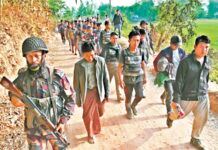The prices of sacrificial animals registered an upward growth in the city markets from Monday noon after experiencing a significant fall over the past two days.
Traders, however, hinted at little possibility of a further fall in cattle prices ahead of this Eid. The market price of each cattle increased by Tk 5,000 – Tk 10,000 depending on size.
Sources claimed that although a good number of Indian cattle entered into the market, the cattle traders allegedly kept the supply controlled and artificially help increase the market price.
Local traders and seasonal cow fatteners had to experience a substantial loss due mainly to large inflow of Indian cattle on the eve of this Eid-ul-Azha, as the downward market trend continued until Monday.
However, many traders of makeshift cattle markets at Motijheel, Kamalapur, Arambag and Armanitola said they are now quite happy following the rise in demand Monday.
“I’ve already incurred Tk 25,000 loss in selling three animals Sunday and the current market trend indicates that I’ve to suffer more,” said trader Abu Sayeed, who brought seven medium sized cows to Motijheel cattle market from Natore.
He said buyers offered a maximum price of Tk 55,000 for one of his oxen, which he bought at Tk 65,000 a couple of weeks ago. “Tell me, how I can make profits,” he said, adding he had borrowed Tk 400,000 on interest for 15 days from a local lender.
According to the traders, they had to pay between Tk 4,000 and Tk 5,000 in interest for an amount of Tk 100,000 loan covering a 15-day timeframe.
Seasonal cattle trader Mohammad Shahin, who came to Arambagh cattle market from Sirajganj, told the FE that he had incurred a loss of Tk 20,000 by selling four sacrificial animals until Monday afternoon. “I came here this year to recover last year’s losses to the tune of Tk 100,000, but unfortunately the situation remains the same. That’s why I have decided not to trade in sacrificial animals in the future,” he said.
The frustrated cattle trader said he had borrowed Tk 200,000 from his relatives for the purpose of cattle trading. “I don’t know what will happen to me,” he said.
Trader Mosharraf Hossain from Chuadanga district said 60 per cent of them conduct the trading on borrowed money. “Many people of the community will not come to the capital next year because of the losses over the two consecutive years,” he said.
The 50-year-old trader said huge numbers of Indian cattle heads have entered Bangladesh illegally with the assistance of the Indian Boarder Security Force (BSF).
“I’m from a bordering district and I know how many Indian animals are coming in. The large inflow of the sacrificial animals has flooded the markets, causing the price fall,” he said.
The lower market price has also inspired some of the buyers to go for purchasing cows instead of goats this year.
Talking to the FE, Shamsul Alam, a government employee, said he had planned to buy a she-goat. He had fixed his budget at Tk 12,000.
“But the current market trend has prompted me to buy a small cow at Tk 25,000,” he said, adding that many people like him opted for cows shifting from goats.
Dhaka South City Corporation (DSCC) has set up 10 makeshift cattle markets, while the Dhaka North City Corporation (DNCC) 9 in the capital. Every year, traders bring cattle to the capital’s markets mainly from Kushtia, Meherpur, Sirajganj, Chapainawabganj, Pabna, Bogra, Jhenidah and Faridpur before Eid-ul-Azha.










